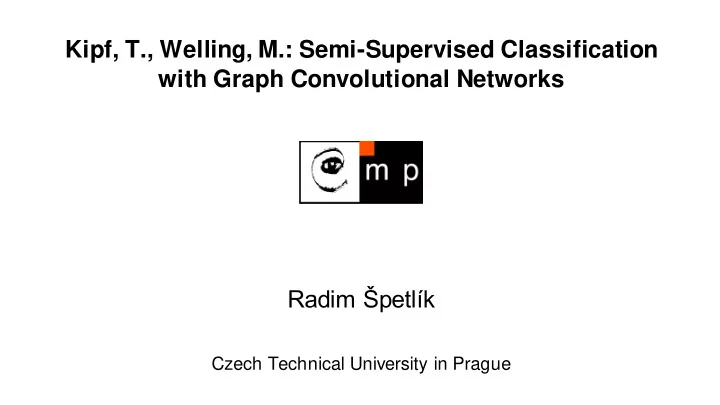

Kipf, T., Welling, M.: Semi-Supervised Classification with Graph Convolutional Networks Radim Špetlík Czech Technical University in Prague
2 Overview - Kipf and Welling - use first order approximation in Fourier-domain to obtain an efficient linear-time graph-CNNs - apply the approximation to the semi-supervised graph node classification problem
3 Graph Adjacency Matrix 𝑩 - symmetric, square matrix - 𝐵 𝑗𝑘 = 1 iff vertices 𝑤 𝑗 and 𝑤 𝑘 are incident - 𝐵 𝑗𝑘 = 0 otherwise http://mathworld.wolfram.com/AdjacencyMatrix.html
4 Graph Convolutional Network - given a graph 𝐻 = 𝑊, 𝐹 , graph-CNN is a function which: - takes as input: - feature description 𝒚 𝒋 ∈ ℝ 𝐸 for every node 𝑗 ; summarized as 𝑌 ∈ ℝ 𝑂×𝐸 , where 𝑂 is number of nodes, 𝐸 is number of input features - description of the graph structure in matrix form, typically an adjacency matrix 𝐵 - produces: - node-level output 𝑎 ∈ ℝ 𝑂×𝐺 , where 𝐺 is the number of output features per node
5 Graph Convolutional Network - is composed of non-linear functions 𝐼 (𝑚+1) = 𝑔(𝐼 𝑚 , 𝐵) , where 𝐼 0 = 𝑌 , and 𝐼 (𝑀) = 𝑎 , and 𝑀 is the number of layers.
6 Graph Convolutional Network - graphically: https://tkipf.github.io/graph-convolutional-networks/
7 Graph Convolutional Network Let’s start with a simple layer -wise propagation rule 𝑔 𝐼 𝑚 , 𝐵 = 𝜏(𝐵𝐼 𝑚 𝑋 𝑚 ) , where 𝑋 (𝑚) ∈ ℝ 𝐸 𝑚 ×𝐸 𝑚+1 is a weight matrix for the 𝑚 -th neural network layer, 𝜏(⋅) is a non-linear activation function, 𝐵 ∈ ℝ 𝑂×𝑂 is adjacency matrix, 𝑂 is the number of nodes, 𝐼 (𝑚) ∈ ℝ 𝑂×𝐸 𝑚 https://samidavies.wordpress.com/2016/09/20/whats-up-with-the-graph-laplacian/
8 Graph Convolutional Network multiplication with 𝐵 not enough, we’re missing the node itself 𝑔 𝐼 𝑚 , 𝐵 = 𝜏(𝐵𝐼 𝑚 𝑋 𝑚 ) , we fix it by 𝑔 𝐼 𝑚 , 𝐵 = 𝜏( መ 𝐵𝐼 𝑚 𝑋 𝑚 ) , where መ 𝐵 = 𝐵 + 𝐽 , 𝐽 is the identity matrix
9 Graph Convolutional Network መ 𝐵 is typically not normalized; this multiplication 𝑔 𝐼 𝑚 , 𝐵 = 𝜏( መ 𝐵𝐼 𝑚 𝑋 𝑚 ) , would change the scale of features 𝐼 (𝑚) 𝐸 − 1 𝐸 − 1 we fix that by symmetric normalization, i.e. 2 𝐵 2 , where 𝐸 is the diagonal node degree matrix of መ 𝐵 , 𝐸 𝑗𝑗 = σ 𝑘 መ 𝐵 𝑗𝑘 , producing 𝐸 − 1 𝐸 − 1 𝑔 𝐼 𝑚 , 𝐵 = 𝜏( 2 𝐼 𝑚 𝑋 𝑚 ) , 2 መ 𝐵
10 Graph Convolutional Network Examining a single layer, single filter 𝜄 ∈ ℝ , and a single node feature vector 𝒚 ∈ ℝ 𝐸
11 Graph Convolutional Network 𝐵 = 𝐵 + 𝐽 , መ 𝐸 𝑗𝑗 = σ 𝑘 መ 𝐵 𝑗𝑘 … renormalization trick
12 Graph Convolutional Network ′ =- 𝜄 1 ′ 𝜄 = 𝜄 0 ′ 𝑀 − 𝐽 𝒚 ′ 𝒚 + 𝜄 1 𝜄 0
13 Graph Convolutional Network ′ 𝑀 − 𝐽 𝒚 ′ 𝒚 + 𝜄 1 𝜄 0 ෨ 𝑀 = 𝑑 𝑀 − 𝐽 , 𝑑 ∈ ℝ 𝒉 𝜾 ⋆ 𝒚 = 𝑉𝒉 𝜾 𝑉 ⊤ 𝒚 Inverse Fourier transform – filtering – Fourier transform
14 Graph Convolutional Network An efficient graph convolution approximation was performed when the multiplication was interpreted as approximation of convolution in Fourier domain using Chebyshev polynomials. where 𝑂 is number of nodes, E is number of edges, 𝐸 𝑚 is number of input channels, 𝐸 𝑚+1 is number of output channels.
15 Overview - Kipf and Welling - use first order approximation in Fourier-domain to obtain an efficient linear-time graph-CNNs - apply the approximation to the semi-supervised graph node classification problem
16 Semi-supervised Classification Task ▪ given a point set 𝑌 = {𝑦 1 , … , 𝑦 𝑚 , 𝑦 𝑚+1 , … ,𝑦 𝑜 } ▪ and a label set 𝑀 = {1,… 𝑑} , where – first 𝑚 points have labels 𝑧 1 , … , 𝑧 𝑚 ∈ 𝑀 – remaining points are unlabeled – 𝑑 is the number of classes ▪ the goal is to – predict the labels of the unlabeled points
17 Semi-supervised Classification Task ▪ graphically: https://papers.nips.cc/paper/2506-learning-with-local-and-global-consistency.pdf
18 graph-CNN EXAMPLE ▪ example: – two-layer graph-CNN 𝐵𝑌𝑋 0 𝑋 1 𝑎 = 𝑔 𝑌, 𝐵 = softmax መ 𝐵 ReLU መ where 𝑋 0 ∈ ℝ 𝐷×𝐼 with 𝐷 input channels and 𝐼 features maps, 𝑋 1 ∈ ℝ 𝐼×𝐺 with 𝐺 output features per node
19 Graph Convolutional Network - graphically: https://arxiv.org/pdf/1609.02907.pdf
20 graph-CNN EXAMPLE ▪ objective function: – cross-entropy where Y 𝑀 is a set of node indices that have labels, 𝑎 𝑚𝑔 is the element in the l-th row, f-th column of matrix 𝑎 , ground truth: 𝑍 𝑚𝑔 is 1 if instance 𝑚 comes from a class 𝑔 .
21 graph-CNN EXAMPLE - RESULTS ▪ weights trained with gradient descent
22 graph-CNN EXAMPLE - RESULTS ▪ different variants of propagation models
23 graph-CNN another EXAMPLE ▪ 3- layer GCN, “karate - club” problem, one labeled example per class: 300 training iterations
24 Limitations - Memory grows linearly with data - only works with undirected graph - assumption of locality - assumption of equal importance of self-connections vs. edges to neighboring nodes መ 𝐵 = 𝐵 + 𝜇𝐽 where 𝜇 is a learnable parameter.
25 Summary - Kipf and Welling - use first order approximation in Fourier-domain to obtain an efficient linear-time graph-CNNs - apply the approximation to the semi-supervised graph node classification problem
26 Thank you very much for your time…
27 Answers to Questions ሚ 𝐵 = 𝐵 + 𝜇𝐽 𝑂 - The lambda parameter would control the influence of neighbouring edges vs. self-connections. - How (or why) would the lambda parameter trade-off also between supervised and unsupervised learning?
Recommend
More recommend